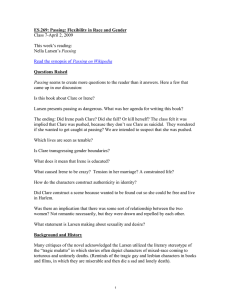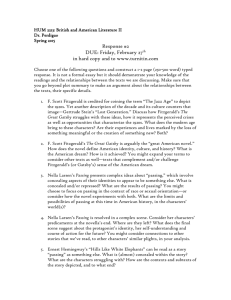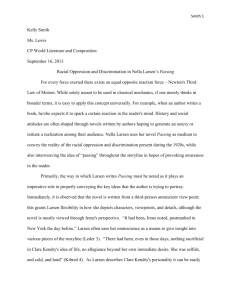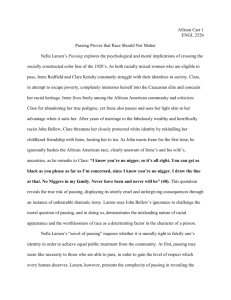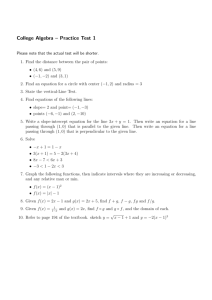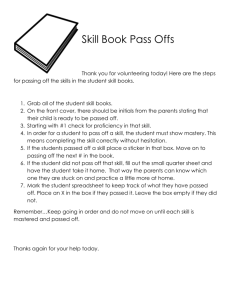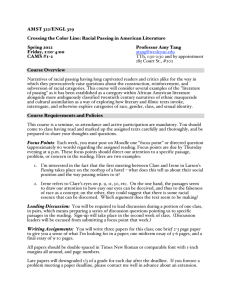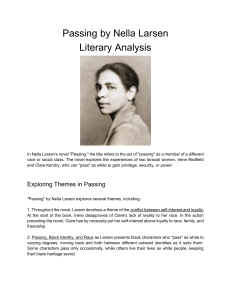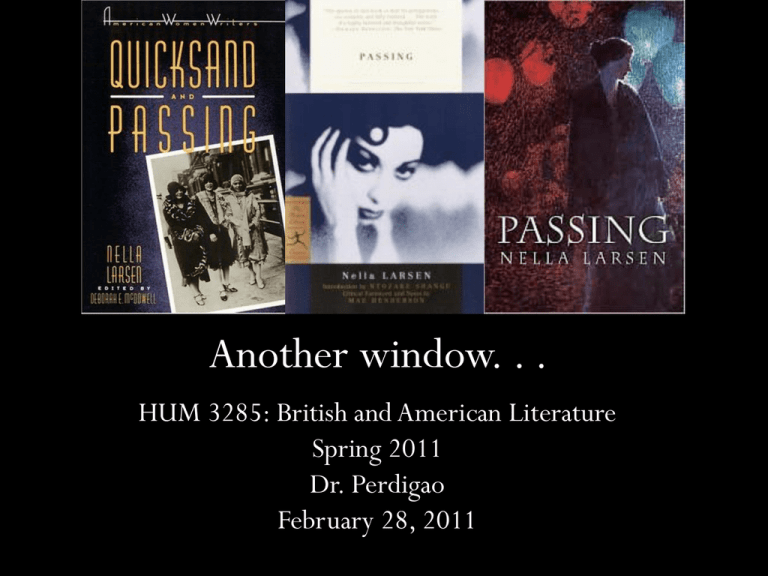
Another window. . .
HUM 3285: British and American Literature
Spring 2011
Dr. Perdigao
February 28, 2011
Nella Larsen (1891-1964)
•
Born in Chicago as Nellie Walker; daughter of white Danish mother Marie Hanson
and black West Indian father Peter Walker
•
Father died when Larsen was young; mother remarried Scandinavian man Peter
Larsen
•
Larsen claimed to have lived in Denmark, returned to attend University of
Copenhagen but scholars have not found support
•
Studied at Fisk University, studying nursing (1907-1908), then Lincoln Hospital
School of Nursing in NYC (1912-1915); worked for Tuskegee Institute’s Andrew
Memorial Hospital as head nurse, then NYC’s Board of Health
•
1919—married research physicist Dr. Elmer S. Imes; went from working class to
African American middle class
•
Employed at 135th Street branch of NY Public Library; met writers in Harlem;
entered Library School of the NY Public Library in 1922
Nella Larsen (1891-1964)
•
Carl Van Vechten (Hugh Wentworth) claimed to have discovered her, introduced
her to Knopf publishers
•
Quicksand (1928): Helga Crane, daughter of white mother and black father; teacher
at Naxos; travels to Denmark; considered exotic; returns to America; questions of
race in America, abroad: South: Chicago: Harlem: Copenhagen: NYC: South;
desire for control over her body and identity—resulting in quicksand, loss of
autonomy and agency
•
Passing (1929); Harmon Foundation’s bronze medal for achievement in literature;
Guggenheim Fellowship in creative writing (1930); writes in Spain and France--for
novels on racial freedom and husband’s infidelity; divorce in 1933, failure to
publish third novel; loss of status in return to nursing; stops writing in the late
1930s
•
Charges of plagiarism for story “Sanctuary” (1930); Sheila Kaye-Smith’s story
“Mrs. Adis” published in 1922
•
Lost connections to other New York writers; former husband died in 1941; worked
as nurse in NYC hospitals until death in 1964
Nella Larsen (1891-1964)
•
Recovery of her work in 1970s
•
Passing (1929): Irene Redfield, Clare Kendry; passing in America; racial identity;
psychological doubles; themes of racial passing, class and social mobility, and
female desire
•
Ideas of safety and security versus risk
•
Passing as “a device for encoding the complexities of human personality, for veiling
women’s homoerotic desires, and for subverting simplistic notions of female selfactualization” (Thadious M. Davis 253)
•
Female sexuality—ideas about domestic sphere in relation to a “woman’s quest for
satisfaction and completion” (Davis 253).
•
Works end with “irreparable breakdown of illusions about emancipatory strategies
or possible futures for women” (Davis 253).
Negotiating Passing
•
•
•
•
•
Ideas about Africa—Irene, Brian
“Heritage” poems: Cullen, Bennett, McKay
America—uplift; NWL
Brazil
Being American—Clare, Toomer
•
•
•
Mrs. Dalloway—tea, party; buying flowers; planning parties
Security, stability
Septimus: Clare; window as symbol
•
Cigarette: Clare
•
Repression, fainting
•
Subconscious
Negotiating Passing
•
Walter White, former director of NAACP, had encouraged Larsen to complete
Quicksand
•
Van Vechten introduced novel to his publisher; Du Bois praised the novel
•
Contemporary critics questioning endings of stories—like Fauset and Hurston—
sacrifice of independent female identities
•
Marriage and death as themes
•
Conflicting ideas about racial and sexual identities, a black and feminine aesthetic
•
Ideology of romance—marriage and motherhood
•
Repressed female sexual experience
•
Ideas about black female sexuality—insisting on chastity like the purity of
Victorian bourgeoisie (McDowell xiii)
Negotiating Passing
•
How does one identify him/herself and why? What happens when academics,
philosophers, and sociologists change the terms on you?
•
What does it mean to be black, middle class, and a woman?
•
Ideology=social constructions that can confine groups; system of beliefs established
and becomes part of “cultural norm”
•
Race, class, and gender are constructs; we created race through language (real but
manmade)
•
Carole Vance writes, “Sexuality is simultaneously a domain of restriction,
repression, and danger as well as a domain of exploration, pleasure, and agency”
(qtd. in McDowell xiv).
•
Ideas of pleasure and danger in both texts
•
19th century ideas about sexuality but flirtation with “female sexual desire”
connects them to the liberation of the 1920s (McDowell xiv).
Negotiating Passing
•
Doubles—offering ideas about the relationship between black women and desire
and sexuality versus the idea of the black woman as respectable in middle-class
terms (McDowell xvi)
•
Sexless marriages for both characters
•
fear of dark child; protecting sons from it; sex as joke; separate bedrooms
•
Irene as unreliable narrator, as central consciousness, her fears
•
Irene’s emerging sexuality—from rooftop to tea party to own bedroom
•
Repressing feelings
•
Concealment and burial
•
Letter inciting desire
Negotiating Passing
•
Clare—as symbol of desire, dressed in red
•
Projection of Irene’s desire onto Brian—question if there is an affair
•
Cheryl Wall’s description of a “Psychological suicide, if not a murder” (qtd. in
McDowell xxix)
•
Cigarettes—snuffing them out
•
Text as concealment as well—veiled references, what is permitted
•
“Implying false, forged, and mistaken identities, the title functions on multiple
levels: thematically, in terms of the racial and sexual plots; and strategically, in
terms of the narrative's disguise. . . The novel performs a double burial: the erotic
subplot is hidden beneath its safe and orderly cover and the radical implications of
that plot are put away by the disposal of Clare” (xxx).
Negotiating Passing
•
“In ending the novel with Clare’s death, Larsen repeats the narrative choice which
Quicksand makes: to punish the very values the novel implicitly affirms, to honor
the very value system the text implicitly satirizes” (McDowell xxxvi).
•
Novel passes
•
Dichotomies—lady/Jezebel; virgin/whore (McDowell xxxi)
•
Social institutions of education, marriage, religion, all strangling and controlling
sexual expression of women

